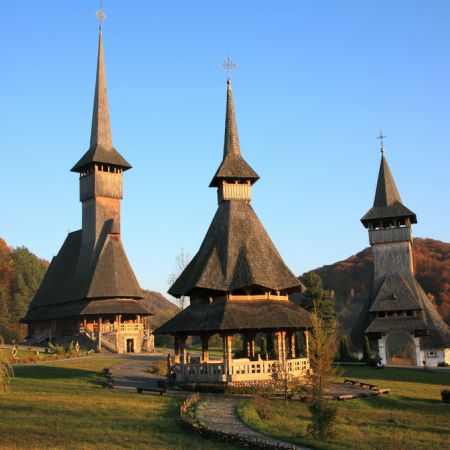Top 10 interesting places in Romania
10) Sibiu City

The old town. European Capital of culture in 2007, Sibiu inherited a diversity of culture (Romanians, Germans and Hungarians have been living here together for a long time). Interesting buildings and middle-age atmosphere.
If you go in the area, don't miss Astra Museum of Traditional Technique - open all summer and presenting households from allover Romania - Europe's largest open-air museum.
9) Parliament House in Bucharest.

If you go to Bucharest, also visit the Village museum. A small village in the middle of Bucharest, with houses brought here at the beginning of the last century.
8) Râmeţi Gorge.

If you go in the area, also visit Cetaţile Ponorului, a citadel sculpted in stone by the Nature itself.
7) Maramureş
County

The wooden
churches, of which some are build in the XII-th century are still used today
for religious ceremony. They are the tallest wooden buildings in Europe . I also recommend Maramureş
for its rich lifestyle, that you can still observe nowadays. People dressed in
old costumes, going to the church on Sunday is a normal thing here.
If you go in the area, visitSăpânţa Merry
Cemetery
If you go in the area, visit
6) Muddy Volcanoes in
Buzău
County

Unique phenomena, the muddy
volcanoes are a nature curiosity that you won't see in many places of the word.
With a moon-like landscape, this geological and botanical reservation is a great
place for photography. Gas coming from 3000 m deep push up water together with
soil, forming the "boiling mud".
If you go in the area, go also visit the living fire in Lopătari. Natural gas emerge from the underground, so it ignites during the summer and fires can be seen on the hill. Photo by bitsofreality
If you go in the area, go also visit the living fire in Lopătari. Natural gas emerge from the underground, so it ignites during the summer and fires can be seen on the hill. Photo by bitsofreality
The town has been continuously
inhabited since its first attestation in 1291, under the name Castrum Sex or
Castrum Seg (meaning the town on the hill). the historic center being part of
UNESCO world heritage, the houses cannot be modified by current owners, so they
still conserve the atmosphere of the late middle-ages. Go there during
the week and, if possible off the tourist season, when it is less crowded and
you'll still see the kids going to the school on the hill, climbing the covered
snow that was intended to protect them from heavy snow and rain. (OK, Sighişoara
is the birth place of Vlad III Dracula, the Walachia ’s ruler that was the inspiration for Bram Stoker's
novel Dracula. But that's not the main interesting things about
Sighişoara).
If you go in the area go visit the fortified citadel in Biertan.
If you go in the area go visit the fortified citadel in Biertan.
4) Fortified Churches in
South-Eastern Transylvania .
As you probably know, Transylvania has a rich history, with a lot of events
going on since the XII-th century until the end of WW I. In the middle ages,
people was building defending fortifications in each village in order to protect
themselves, the families and the goods from the invaders. The majority of the
fortifications are built in the XII-th - XIV-th century and are well
preserved.
If you go in the area, try not to miss Râşnov citadel, that has recently been restored and is one of the most beautiful in South-Eastern Europe.
If you go in the area, try not to miss Râşnov citadel, that has recently been restored and is one of the most beautiful in South-Eastern Europe.
3) The wild Carpathian Mountains.
Unlike some other mountains in
Europe , the Carpathians have many spots where men
still didn't reach. Or meadows where only shepherds with a flock of ships wander
around all summer. But as one cannot visit all the Carpathians range, I'll chose
one place for this top: Făgăraş
Mountains - Romania's highest mountains, with one of Europe's longest
continuous ridge over 2000 m. Caution should be taken due to unstable weather
over 2000 m. Hey, but wait, that's just mountain weather, isn't it ?
The Voroneţ Blue, for example is famous worldwide. It seldom
happens that a place gives a name to a color. But here in Bucovina , the blue is not a normal one. What makes the
painted monasteries part of UNESCO World Heritage is the exterior painting kept
intact since the XV-th Century. Piece of mind, relax, learn a lot of history,
that's why I would go there anytime.Moldoviţa, Suceviţa or Gura Humorului
definitely deserve a visit.
If you go in the area, you might consider a rafting and horse-riding trip in Rodnei andBistriţa Mountains
If you go in the area, you might consider a rafting and horse-riding trip in Rodnei and
1) Danube Delta
- UNESCO
reservation of biosphere, it's the Europe's newest
land and the biggest delta in
Europe, except Volga 's one. Over 315 species of
birds, some of them very rare, like the Dalmatian Pelican or the red crested
duck, a fantastic landscape of reed and water, an unique lifestyle based of
fishing and a great opportunity for outdoor sports, that’s why I choose it as
the number one place. While you can go by yourself, presence of a specialised
guide is highly recommended, to help you travel on the channels (eventually in a
canoe or kayak), show you the birds, animals and plants.





No comments:
Post a Comment